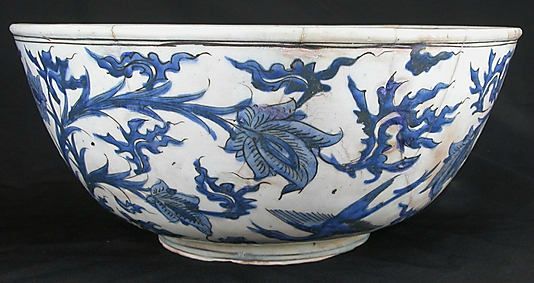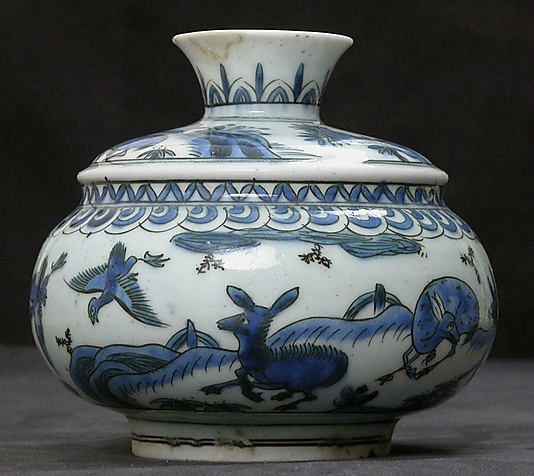Some blue and white Islamic 'chinoisries' at the MET
Jar with Lion and Landscape Elements. Iran, first half 18th century. Stonepaste; painted under transparent glaze; brass. H. 11 in. (27.9 cm). Theodore M. Davis Collection, Bequest of Theodore M. Davis, 1915. 30.95.160a, b. The MetropolitanMuseum of Art. © 2000–2013 The Metropolitan Museum of Art.
The centuries-long popularity of Chinese ceramics in the Islamic world continued into the Safavid era in Iran, as attested by pieces like this which were inspired by the shapes and conventions of painting particular to China. Of course, the most popular types were copies of blue-and-white ware. The staid depiction of a flowering landscape in a black and gray wash on a white background is interrupted by the humorous figure of a dandelion-headed lion. The foot rim, mouth rim, and cover of this jar were made of brass or silvered copper.
Bottle. Iran, 17th century. Stonepaste; painted under a transparent glaze; copper alloy. H. 4 7/8 in. (12.4 cm) Diam. 5 3/4 in. (14.6 cm). Anonymous Gift, 1974. 1974.370.13. The Metropolitan Museum of Art. © 2000–2013 The Metropolitan Museum of Art.
Bottle with Running Quadrupeds. Iran, 17th century.. Stonepaste; painted in blue under transparent glaze. H. 12 5/16 in. (31.3 cm) Gr. D. 7 15/16 in. (20.2 cm). Rogers Fund, 1970. 1970.38. The Metropolitan Museum of Art. © 2000–2013 The Metropolitan Museum of Art.
Dish with a Swimming Duck. Iran, 16th century. Stonepaste; painted in blue under transparent glaze (Kubachi ware). H. 3 1/4 in. (8.3 cm) Diam. 13 1/4 in. (33.7 cm). Gift of Mr. and Mrs. Lester Wolfe, 1968. 68.223.12. The Metropolitan Museum of Art. © 2000–2013 The Metropolitan Museum of Art.
Dish with a Lotus Design. Iran, 16th century. Stonepaste; painted in blue under transparent glaze ("Kubachi" ware). D. 13 in. (33 cm). Rogers Fund, 1908. 08.157.4. The Metropolitan Museum of Art. © 2000–2013 The Metropolitan Museum of Art.
This dish belongs to a group of ceramics known as Kubachi ware. Named for a village in the Caucasus where this pottery was discovered in quantity, Kubachi wares are now thought to have actually been produced in Tabriz. One attribute of the Kubachi style is an uneven application of the glaze that has resulted in a surface-wide crackle. Dirt has seeped into the cracklure, discoloring the underlying body to a brownish tint.
Like so many ceramics produced in Iran during the Safavid Period, the style and decoration of this dish was inspired by the highly-regarded Chinese porcelain. The central lotus flower, use of blue and white coloring, as well as the wave pattern on the flat rim illustrate the Chinese influences in this piece.
Dish with Two Fighting Lions. Iran, possibly Mashhad, ca. 1635. Stonepaste; incised and painted under transparent glaze. H. 3 1/4 in. (8.3 cm) Diam. 17 1/16 in. (43.4 cm). Rogers Fund, 1924. 24.47.4. The Metropolitan Museum of Art. © 2000–2013 The Metropolitan Museum of Art.
In the second quarter of the seventeenth century, Chinese blue-and-white porcelain production decreased and Iranian potters stepped up manufacture of Chinese-inspired blue-and-white ceramics. The two lions, the swirling fleshy clouds with their vegetal appearance, and the repeating scroll all allude to blue-and-white Chinese export ware.
Imitation Blue-and-white Bowl. Iran, possibly Mashhad, 17th century. Stonepaste; painted in blue under transparent glaze. 7 1/2 x 14 1/4 in. (19.1 x 36.2 cm). Bequest of Nellie Kuh, by exchange, Louis V. Bell Fund, and funds from various donors, 1967. 67.108. The Metropolitan Museum of Art. © 2000–2013 The Metropolitan Museum of Art.
Like so many ceramics produced in Iran during the Safavid period, the style and decoration of this dish shows an attempt to emulate the highly-regarded Chinese porcelain. This is illustrated by the blue and white color scheme, as well as the distinctly Chinese imagery of pagoda structures and figures wearing local dress. Moreover, there is an imitation Chinese seal-mark on the base, which in Chinese porcelain would have indicated the dynasty and Emperor. That Iranian potters included this detail indicates the great lengths to which they went to make their wares comparable to the Chinese originals.
Bowl with Flowering Plants. Iran, Mashhad, 16th–17th century. Stonepaste; painted in blue under transparent glaze. H. 7 in. (17.8 cm) D. 15 3/4 in. (40 cm) Gift of Nasli Heeramaneck, 1964. 64.109. The Metropolitan Museum of Art. © 2000–2013 The Metropolitan Museum of Art.
Bowl with Pagodas and Landscape Elements. Iran, Mashhad, 18th century. Stonepaste; painted under a transparent glaze. H. 2 7/8 in. (7.3 cm) Diam. 11 1/2 in. (29.2 cm). Rogers Fund, 1915. 15.86.1. The Metropolitan Museum of Art. © 2000–2013 The Metropolitan Museum of Art.
Vase with Animals in a Landscape. Iran, 17th century. Stonepaste; painted in blue under transparent glaze. H. 4 3/4 in. (12.1 cm) D. 5 5/16 in. (13.5 cm). Harris Brisbane Dick Fund, 1966. 66.107.6. The Metropolitan Museum of Art. © 2000–2013 The Metropolitan Museum of Art.
Like so many ceramics produced in Iran during the Safavid period, the style and decoration of this dish demonstrates an attempt to emulate the highly-regarded Chinese porcelain. This is illustrated by the blue and white color scheme, as well as the imagery of animals in a landscape. Moreover, on the base is an imitation Chinese seal-mark, which in Chinese porcelain would have indicated the dynasty and Emperor. That Iranian potters included this detail indicates the great lengths that artists went in order to make their wares comparable to the Chinese originals.
Dish. Iran, late 16th–early 17th century. Stonepaste; painted in blue under a transparent glaze. H. 3 in. (7.6 cm) D. 13 1/2 in. (34.3 cm). Gift of Elizabeth S. Ettinghausen, in memory of Richard Ettinghausen, 1979. 1979.519. The Metropolitan Museum of Art. © 2000–2013 The Metropolitan Museum of Art.
Like so many ceramics produced in Iran during the Safavid period, the style and decoration of this dish was an attempt to emulate the highly-regarded Chinese porcelain wares. This is illustrated by the blue and white color scheme, as well the floral motifs. Pseudo-Chinese calligraphy has been painted on the reverse of the plate, a detail which illustrates the great lengths to which artists went to make their wares comparable to Chinese originals.
Vase. Iran, 17th century. Stonepaste; painted under a transparent glaze. 8 1/2 in. (21.6 cm). Rogers Fund, 1924. 24.47.1. The Metropolitan Museum of Art. © 2000–2013 The Metropolitan Museum of Art.
Tulip Vase. Iran, 17th century. Stonepaste; painted in blue under transparent glaze. H. 10 3/16 (25.9 cm) Diam. 6 1/2 in. (16.5 cm). Harris Brisbane Dick Fund, 1966. 66.107.1. The Metropolitan Museum of Art. © 2000–2013 The Metropolitan Museum of Art.

/https%3A%2F%2Fprofilepics.canalblog.com%2Fprofilepics%2F1%2F0%2F100183.jpg)
/https%3A%2F%2Fstorage.canalblog.com%2F03%2F02%2F119589%2F96711876_o.jpg)
/https%3A%2F%2Fstorage.canalblog.com%2F11%2F31%2F119589%2F94773502_o.jpg)
/https%3A%2F%2Fstorage.canalblog.com%2F20%2F83%2F119589%2F94772815_o.jpg)
/https%3A%2F%2Fstorage.canalblog.com%2F26%2F72%2F119589%2F75604929_o.jpg)
/https%3A%2F%2Fstorage.canalblog.com%2F59%2F60%2F119589%2F26458628_o.jpg)



















/http%3A%2F%2Fstorage.canalblog.com%2F21%2F96%2F119589%2F129836760_o.jpg)
/http%3A%2F%2Fstorage.canalblog.com%2F33%2F99%2F119589%2F129627838_o.jpg)
/http%3A%2F%2Fstorage.canalblog.com%2F07%2F83%2F119589%2F129627729_o.jpg)
/http%3A%2F%2Fstorage.canalblog.com%2F28%2F37%2F119589%2F129627693_o.jpg)